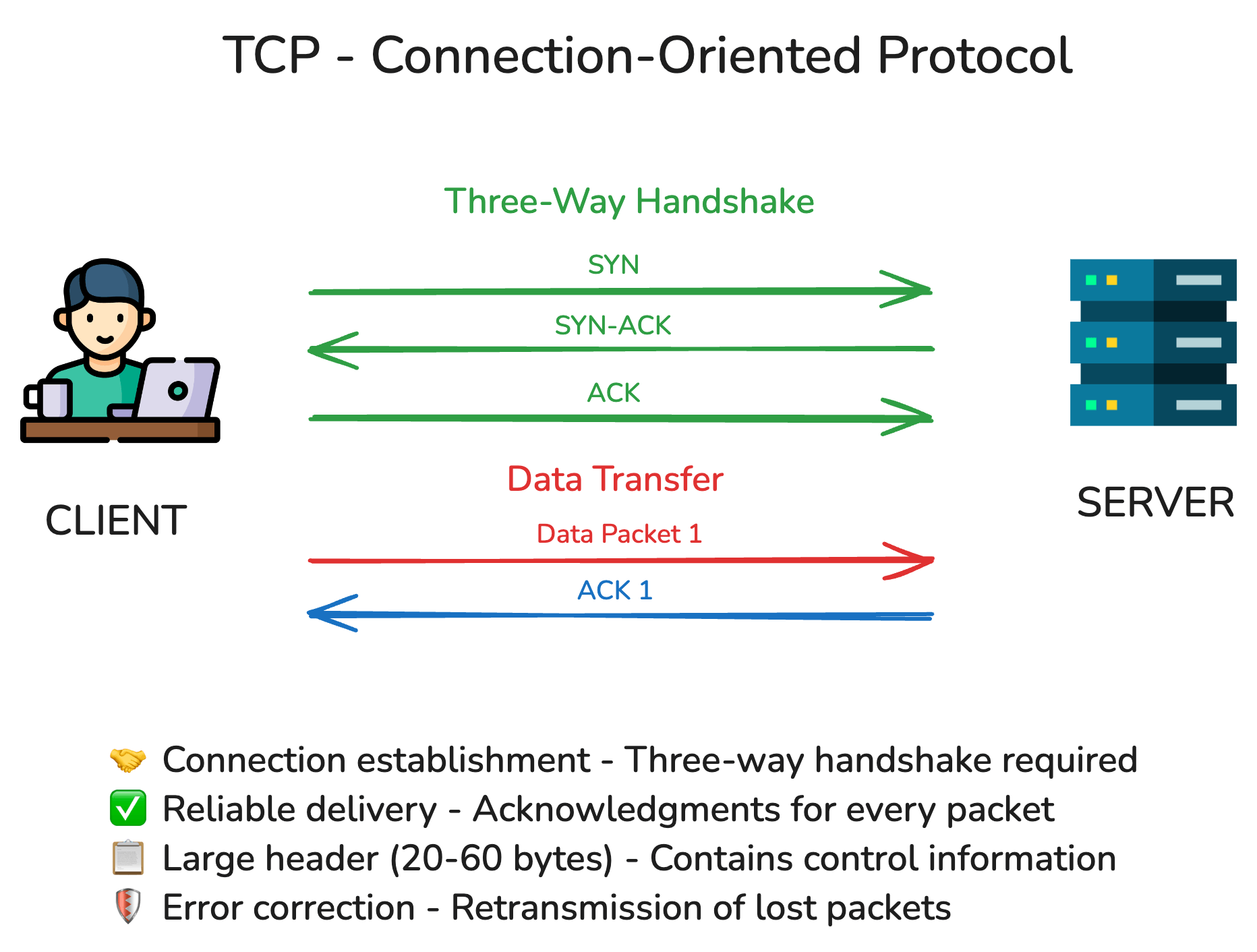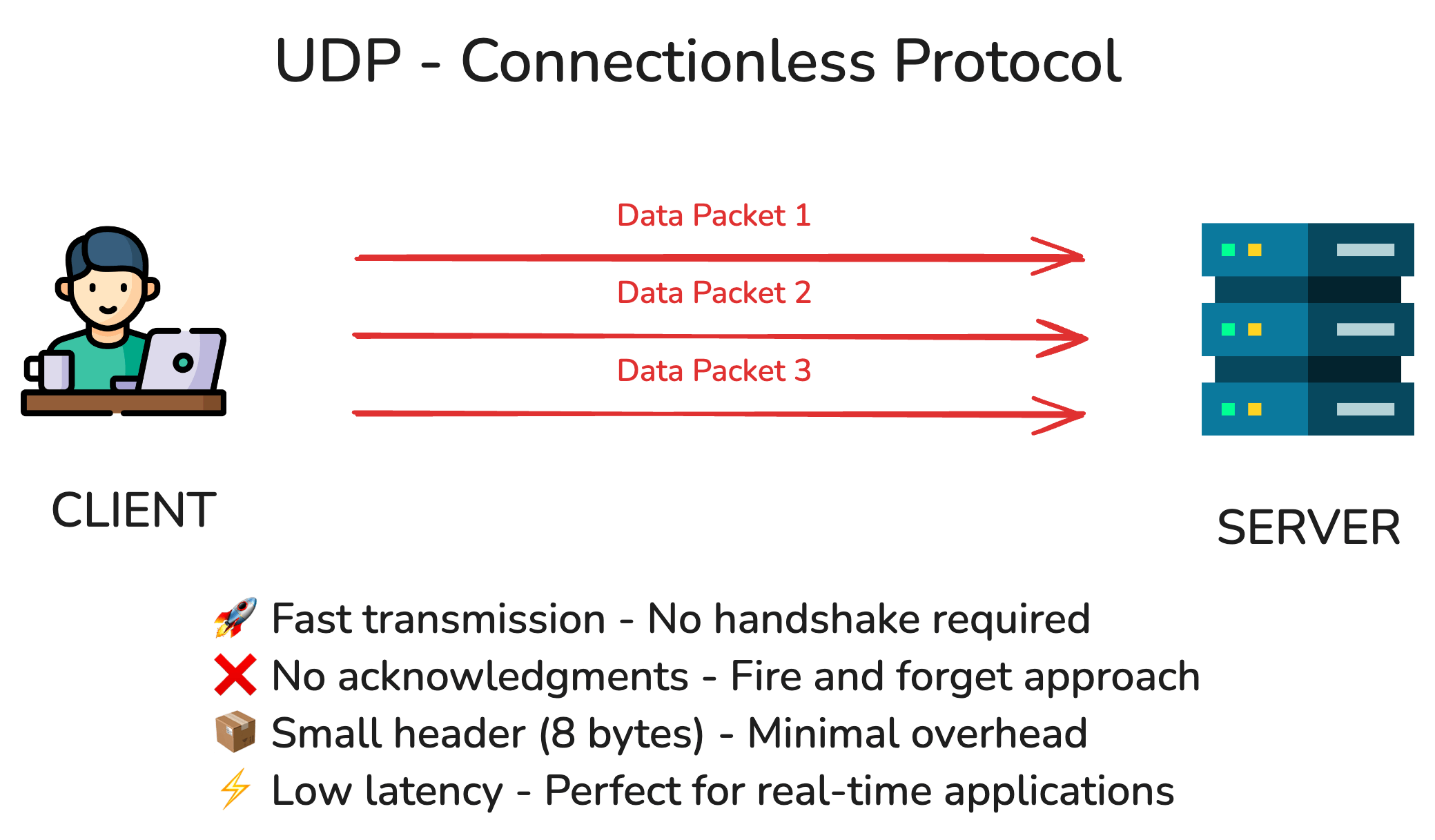
When building network applications, developers face a fundamental choice between two core internet protocols: TCP and UDP. This decision can make or break your application’s performance, affecting everything from user experience to system reliability.
Understanding the differences between UDP and TCP isn’t just academic knowledge - it’s practical wisdom that determines whether your online game feels responsive, your video call stays smooth, or your financial transaction completes successfully.
Summary
TCP (Transmission Control Protocol)
- Reliable, connection-oriented protocol with guaranteed delivery
- Best for web browsing, email, file transfers, and financial transactions
- Slower due to error checking and acknowledgments
UDP (User Datagram Protocol)
- Fast, connectionless protocol with no delivery guarantees
- Perfect for gaming, live streaming, video calls, and real-time applications
- Use Pinggy for UDP tunneling
Key Differences
- TCP: Reliable but slower (100-200ms latency)
- UDP: Fast but may lose packets (1-10% loss rate)
- TCP header: 20-60 bytes vs UDP header: 8 bytes
When to Choose
- Choose TCP when data integrity is critical
- Choose UDP when speed and low latency matter most
What are TCP and UDP?
Both TCP (Transmission Control Protocol) and UDP (User Datagram Protocol) operate at the transport layer of the internet protocol suite. They’re responsible for moving data between applications across networks, but they take fundamentally different approaches to this task.
TCP establishes a reliable connection between sender and receiver through a three-way handshake. It guarantees that every piece of data arrives intact and in the correct order, making it the go-to choice for applications where data accuracy is non-negotiable.

UDP, on the other hand, takes a “fire and forget” approach. It sends data without establishing connections or waiting for confirmations, prioritizing speed over guaranteed delivery.

Key differences between UDP and TCP
The fundamental differences between these protocols shape how they perform in real-world scenarios:
Connection Management
- TCP requires a connection setup before data transmission
- UDP sends data immediately without connection establishment
Reliability
- TCP provides 99.9% delivery success through error checking and retransmission
- UDP accepts 1-10% packet loss in exchange for speed
Speed and Latency
- TCP typically adds 100-200 milliseconds due to acknowledgments and error correction
- UDP offers significantly lower latency for time-sensitive applications
Header Size
- TCP headers range from 20-60 bytes, containing extensive control information
- UDP headers are fixed at 8 bytes, minimizing overhead
When to use TCP
TCP shines in scenarios where data integrity trumps speed. Its reliability mechanisms make it essential for applications that cannot tolerate data loss or corruption.
Web Browsing and HTTP/HTTPS
Every time you visit a website, TCP ensures that HTML, CSS, and JavaScript files arrive completely and in order. A missing piece of code could break the entire page, making TCP’s reliability crucial for web applications.
Email Services
Email protocols like SMTP, POP3, and IMAP rely on TCP to guarantee message delivery. You wouldn’t want parts of your important emails to disappear during transmission.
File Transfers
Whether you’re downloading software, uploading documents, or syncing files to cloud storage, TCP ensures every byte arrives intact. File corruption from incomplete transfers could render documents unusable.
Financial Transactions
Banking applications and e-commerce platforms depend on TCP’s reliability for secure transactions. The guaranteed delivery and error checking provide the foundation for trustworthy financial operations.
When to use UDP
UDP excels in applications where speed matters more than perfect delivery. Its low overhead and immediate transmission make it ideal for real-time scenarios.
Online Gaming
Multiplayer games need instant responses to player actions. UDP’s speed ensures that when you press a button, the action registers immediately. Games can handle occasional packet loss by interpolating missing data or requesting updates.
Live Video Streaming
Platforms like Twitch and YouTube Live use UDP for video streams because viewers prefer smooth playback over perfect quality. If a few frames are lost, the stream continues without interruption.
Video Conferencing
Applications like Zoom and Skype prioritize real-time communication over perfect audio/video quality. UDP enables natural conversations by minimizing delay, even if occasional glitches occur.
DNS Queries
Domain name lookups use UDP because they’re typically small, single-packet requests that benefit from UDP’s speed. If a query fails, it’s faster to retry than to establish a TCP connection.
The performance differences between TCP and UDP become apparent in various scenarios:
Gaming Performance
In competitive online games, UDP can provide latencies as low as 20-50 milliseconds, while TCP might add an additional 100-200 milliseconds. This difference can determine victory or defeat in fast-paced games.
Streaming Quality
Live streaming services often use UDP for video data while employing TCP for control messages and chat features. This hybrid approach balances speed with reliability where it matters most.
Network Conditions Impact
Under poor network conditions, TCP’s retransmission mechanisms can cause significant delays as it waits for acknowledgments. UDP continues transmitting, allowing applications to implement their own recovery strategies.
Hybrid approaches and modern protocols
Many modern applications don’t choose exclusively between TCP and UDP. Instead, they use both protocols strategically:
QUIC Protocol
Google’s QUIC protocol builds reliability features on top of UDP, combining UDP’s speed with TCP-like reliability. This approach powers HTTP/3 and modern web applications.
Gaming Applications
Many games use UDP for real-time gameplay data while employing TCP for critical information like player authentication, game state synchronization, and chat messages.
Streaming Services
Netflix uses TCP for video-on-demand content where buffering is acceptable, but switches to UDP-based protocols for live events where real-time delivery is crucial.
How Big Tech Picks TCP or UDP
Even the biggest tech companies have to pick between TCP and UDP, and they choose based on what their apps need most: speed, reliability, or a mix of both.
Google – YouTube & Search
When you watch YouTube or do a Google search, you are often using QUIC, which runs on UDP. It skips the slow handshake that TCP does and starts sending data right away. QUIC still makes sure things arrive in order, so you get the speed of UDP without stuff going missing. This is why videos and pages load faster even on a bad connection.
Microsoft – Teams
Teams uses UDP for voice and video calls because speed matters more than perfection. A small glitch in the audio is fine but a long delay is not. When you send a chat or share a file, Teams switches to TCP so nothing gets lost.
Netflix – Movies vs Live Streams
For shows and movies, Netflix uses TCP so every bit of the video is perfect even if it takes a couple of seconds to start. For live events, they use UDP-based tech to cut down delay so you are not reacting way after everyone else.
UDP tunneling with Pinggy
Pinggy offers robust UDP tunneling capabilities that make it easy to expose UDP-based applications to the internet, even when you’re behind NAT or restrictive firewalls. This is particularly valuable for gaming servers, real-time applications, and IoT devices that rely on UDP for optimal performance.
Creating a UDP tunnel
Setting up a UDP tunnel with Pinggy is straightforward. Simply run this command in your terminal:
Replace 8080 with the UDP port your application is using. This command will:
- Create a secure tunnel to your local UDP service
- Provide you with a public endpoint that forwards traffic to your local port
- Work even behind CG-NAT and restrictive corporate firewalls
Use cases for UDP tunneling
Gaming Servers: Host multiplayer game servers from your home network and allow friends to connect from anywhere. The low latency of UDP combined with Pinggy’s optimized infrastructure ensures smooth gameplay.
IoT Device Testing: Expose UDP-based IoT devices for remote testing and monitoring without complex network configurations.
Real-time Applications: Share live streaming applications, voice chat servers, or real-time data feeds with external users.
Development and Testing: Test UDP-based applications with remote team members or clients without deploying to cloud infrastructure.
The combination of UDP’s speed and Pinggy’s reliable tunneling creates an ideal solution for applications that need both performance and accessibility.
Conclusion
Understanding UDP vs TCP is fundamental for anyone working with networked applications. TCP provides the reliability foundation for the modern web, ensuring that emails arrive, web pages load completely, and financial transactions process securely. UDP enables the real-time experiences we’ve come to expect from gaming, streaming, and communication applications.
The choice between these protocols isn’t always binary. Modern applications often use both, leveraging TCP’s reliability for critical operations and UDP’s speed for real-time features. By understanding their strengths and limitations, developers can build applications that deliver optimal performance for their specific use cases.
Whether you’re building the next great multiplayer game or a mission-critical business application, choosing the right protocol is a decision that will impact your users’ experience every day.